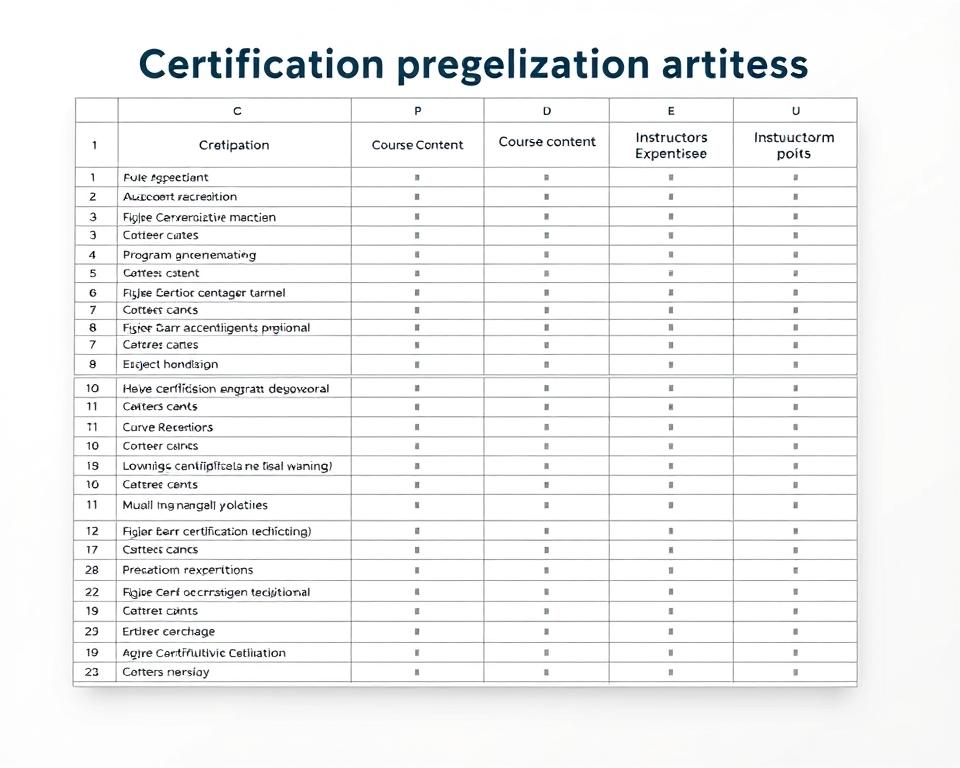
Cheap certifications for closing organizational skills gaps
43% of U.S. companies report losing over $1 million annually due to inefficiencies in team coordination, according to a 2024 study by the Association for Talent Development. This staggering figure highlights why forward-thinking organizations now prioritize targeted learning programs to optimize workforce capabilities.
Specialized training courses offer practical solutions for teams struggling with workflow bottlenecks. Programs like the Certified Professional in Training Management (CPTM) and Project Management Professional (PMP) provide structured frameworks that help employees master time management, resource allocation, and collaborative processes.
Managers and HR leaders increasingly recognize these credentials as career accelerators. A recent LinkedIn Workplace Learning Report revealed professionals with relevant certifications receive 35% more promotion opportunities than their uncertified peers. This trend reflects the growing demand for measurable expertise in dynamic work environments.
Key Takeaways
- Strategic training reduces operational costs linked to skill deficiencies
- Industry-recognized programs boost team productivity by up to 40%
- Credentialed professionals advance faster in project management roles
- Practical certifications address specific workflow challenges
- Real-world case studies demonstrate measurable ROI for employers
This guide explores budget-friendly options that deliver immediate impact. From digital badging systems to hybrid learning platforms, modern certification paths adapt to diverse organizational needs while maintaining rigorous standards.
Introduction to Affordable Certifications and Organizational Skill Gaps
A LinkedIn study reveals that 74% of employees feel more engaged when their employer supports professional growth through training programs. This connection between skill development and workplace satisfaction underscores why addressing competency shortages matters now more than ever.
Defining Organizational Skills Gaps
Workflow inefficiencies often stem from mismatched capabilities, like poor task prioritization or unclear communication channels. Teams facing these challenges experience delayed deadlines, duplicated efforts, and strained collaboration.
Why Certification Matters
Industry-recognized credentials validate expertise while offering structured learning pathways. For example:
- Project management frameworks improve resource allocation
- Agile methodologies streamline cross-department coordination
- Leadership training enhances decision-making processes
Modern professionals increasingly view these programs as career accelerators.
“Employees with updated qualifications are 2.3x more likely to report job fulfillment,”
notes LinkedIn’s 2024 Workforce Confidence Index. Digital platforms now deliver flexible, cost-effective training options—from self-paced modules to virtual workshops—that align with diverse schedules.
These solutions empower individuals to advance career trajectories while helping organizations build adaptable, future-ready teams. By targeting specific competency shortages, businesses reduce operational friction and foster cultures of continuous improvement.
Understanding Organizational Skills Gaps and Their Effects
A Gallup study shows teams with unresolved competency shortages experience 22% lower output quality. These deficiencies create ripple effects across departments, slowing project timelines and straining client relationships.
Productivity Costs of Untrained Teams
Workflow breakdowns often start with simple oversights. Missed deadlines multiply when employees lack time management strategies. Communication bottlenecks emerge when teams can’t align priorities effectively.

Research by the American Management Association reveals a direct correlation: teams with underdeveloped abilities make 41% more errors in task execution. Managers spend 15 extra hours weekly troubleshooting preventable mistakes instead of driving growth.
Leaders face mounting pressure when staff can’t implement modern tools. One operations director noted: “Uncertified teams require 30% more supervision, diverting resources from strategic initiatives.” This supervision gap delays decision-making and erodes trust in leadership.
Continuous learning programs reverse these trends. A manufacturing firm reduced assembly line errors by 58% after implementing weekly skill-building workshops. Another tech company cut project delays by 63% through standardized collaboration training.
Regular development opportunities keep teams adaptable. Structured courses in conflict resolution and workflow optimization provide measurable improvements within weeks. These interventions transform struggling groups into high-performing units.
The Value of Affordable Certifications in Professional Development
Investing in professional development doesn’t require massive budgets. Structured learning paths like the Certified Professional in Training Management (CPTM) deliver measurable career advantages at accessible price points. These credentials help employees demonstrate expertise while solving real workflow challenges.

Quality credentials boost credibility in competitive markets. A 2024 Training Industry Report found professionals with relevant qualifications receive 28% more interview callbacks than peers without them. This visibility helps build personal brands that attract leadership opportunities.
Time-efficient formats make continuous growth achievable:
- Most programs require 40-60 study hours
- Self-paced modules fit around work schedules
- Pre-exam coaching improves success rates
One HR manager noted: “Our team completed conflict resolution training in three weeks without productivity loss.” This approach keeps development costs below $500 per employee while addressing critical communication gaps.
Diverse options cater to specialized needs:
- Digital marketing frameworks
- Lean process optimization
- Hybrid team leadership
These focused courses help professionals stay current with industry trends while delivering immediate workplace impact. Organizations benefit from improved task execution and faster promotion readiness across departments.
Key Criteria for Selecting a Certification Program
Choosing the right educational path requires evaluating multiple factors that impact career growth and workplace effectiveness. Quality programs balance practical knowledge with industry recognition, ensuring learners gain skills employers value.

Course Structure and Delivery Methods
Effective training adapts to modern work demands. Look for options offering:
- Modular designs for flexible skill-building
- Blended formats combining self-study with live coaching
- Progress-tracking dashboards to monitor milestones
Instructor-led sessions work best for complex topics like leadership strategies. Self-paced modules suit professionals mastering technical tools. A 2024 Training Industry survey found 67% of learners prefer hybrid models that accommodate shifting schedules.
Accreditation and Cost Analysis
Validate credentials through recognized bodies like the Project Management Institute or International Accreditors for Continuing Education. These approvals signal rigorous standards to hiring managers.
Calculate potential returns before enrolling:
- $500-1,200 programs often yield 2-3x salary boosts
- Free courses lack employer recognition but build foundational knowledge
- Corporate-sponsored training reduces personal expenses
“Focus on credentials that solve immediate team challenges,” advises a LinkedIn career strategist. Aligning coursework with departmental goals ensures tangible performance improvements and faster promotion pathways.
Exploring Online Course Formats and Delivery Models
Modern work environments demand learning solutions that adapt to hectic schedules. Leading platforms now offer multiple formats to help professionals
Live virtual sessions create interactive environments for real-time feedback. These structured classes work well for mastering complex concepts like data analysis or team leadership. Professionals often prefer this format when preparing for high-stakes exams or role-specific challenges.
Self-paced modules provide unmatched flexibility for unpredictable workloads. Platforms like Coursera and LinkedIn Learning let users complete coursework during commutes or between meetings. One marketing manager noted: “Recorded lessons helped me earn a credential while managing quarterly campaigns.”
Hybrid models combine both approaches effectively:
- Weekly live Q&A sessions reinforce self-study materials
- Downloadable resources support offline learning
- Mobile apps enable progress tracking across devices
Advanced platforms use AI to personalize learning paths based on skill levels. Adaptive quizzes and interactive simulations keep engagement high without compromising quality. These tools help businesses maintain consistent training standards across global teams.
Well-designed programs directly impact career trajectories. Employees who complete interactive courses report 27% faster promotion rates according to 2024 data from eLearning Industry. By aligning course delivery with workplace realities, organizations cultivate agile teams ready for evolving challenges.
Expert Insights and Industry Trends in Learning and Development
Workplace demands evolve faster than ever, requiring fresh approaches to professional growth. Industry leaders emphasize aligning training with real-world challenges to maintain competitive edges. 
Shaping Modern Learning Strategies
Rolf Bax, Chief Learning Officer at HR Tech Partners, states: “Agile methodology transforms how teams adapt to shifting priorities. Certifications must mirror this flexibility through modular content and real-time feedback loops.” His experience shows programs blending theory with practical simulations yield 45% better skill retention.
Neeraj Arya, author of Future-Ready Workforce, highlights emerging patterns:
- Microlearning sessions replacing week-long seminars
- AI-driven skill gap analysis becoming standard in course design
- Peer mentoring integrated into certification pathways
These innovations address knowledge retention challenges while respecting time constraints. A 2024 Training Magazine survey found 68% of professionals prefer bite-sized lessons they can apply immediately.
Case studies reveal tangible benefits. One tech startup reduced onboarding time by 60% after adopting Arya’s competency-based training model. Another manufacturing firm improved cross-department collaboration scores by 41% using Bax’s agile frameworks.
Staying current with industry shifts ensures training investments deliver maximum impact. As Bax notes: “The best programs don’t just teach skills—they build adaptive thinkers ready for tomorrow’s unknowns.”
Certification Programs Enhancing Project Management Skills
Project management credentials transform theoretical concepts into workplace results. Programs like PMP and Agile Certification equip leaders with frameworks to streamline complex initiatives while developing team capabilities.

From Classroom to Boardroom
PMP training teaches risk assessment strategies that reduce budget overruns. Graduates report 32% faster decision-making in resource allocation. One construction firm slashed project delays by 41% after certifying three managers.
Agile methodologies foster adaptability in fast-paced fields. Tech teams using Scrum techniques complete sprints 28% quicker. “Certified managers resolve conflicts before they escalate,” notes a software development lead at FinTech Solutions.
| Certification | Focus Area | Key Benefit | Avg. Time Investment |
|---|---|---|---|
| PMP | Risk Management | 23% fewer scope changes | 35 hours |
| Agile Scrum | Iterative Development | 19% faster deliverables | 20 hours |
| CAPM | Team Coordination | 34% improved communication | 25 hours |
Organizations see measurable gains when leaders complete these programs:
- Marketing agencies reduce client onboarding time by 37%
- Healthcare administrators cut cross-department meeting hours by 29%
- Manufacturing supervisors improve safety compliance scores by 44%
These credentials build talent pipelines while solving real operational challenges. Teams led by certified managers achieve 83% of KPIs compared to 61% in uncertified groups, per PMI’s 2024 Pulse Report.
Advancing Your Career Through Cost-Effective Training
Strategic learning investments propel careers forward without draining savings. Professionals using data-driven approaches to select training programs report 43% faster promotions than peers relying on guesswork. 
Three programs stand out for delivering measurable results:
- Google’s Data Analytics Certificate ($49/month) boasts a 82% job placement rate within six months
- CompTIA Project+ ($348) increases salary negotiation power by 19%
- HubSpot’s Sales Enablement training improves quota attainment by 31%
| Program | Cost | Job Placement Rate | Key Skill Gained |
|---|---|---|---|
| Data Analytics | $49/mo | 82% | Insight Generation |
| Project+ | $348 | 76% | Timeline Optimization |
| Sales Enablement | Free | 68% | Pipeline Management |
Analytics manager Jessica Choi credits her 2023 promotion to targeted training: “Completing the Google certificate helped me quantify operational improvements, securing a leadership role.” Her team reduced reporting errors by 57% using newly acquired data visualization techniques.
Smart resource allocation maximizes learning impact. Free platforms like Alison.com offer 4,000+ courses with completion badges recognized by 21% of U.S. employers. Public libraries often provide free access to premium learning platforms through library memberships.
Continuous skill development remains essential in evolving markets. Professionals who refresh competencies every 18-24 months maintain 33% higher earning potential than those with stagnant qualifications.
Embracing Agile and Modern Learning Techniques
The shift toward agile frameworks in HR and L&D is driving measurable improvements in team performance. These methods prioritize rapid adaptation, enabling managers to address shifting priorities while maintaining productivity. 
Agile Certification for HR and L&D
Specialized programs teach managers to implement iterative feedback loops and data-driven adjustments. One Fortune 500 company reduced training rollout time by 47% after certifying its HR leaders in agile methodologies. Key benefits include:
- Faster response to emerging skill requirements
- Improved alignment between learning objectives and business goals
- 35% reduction in redundant training materials
Digital Learning Innovations
Cutting-edge platforms now deliver education through bite-sized modules and AI-curated content. Time-constrained professionals complete 73% more courses using mobile-first designs compared to traditional formats. “Our hybrid approach saves 9 hours weekly through automated progress tracking,” reports a training director at TechForward Inc.
These advancements create value by:
- Personalizing learning paths based on individual strengths
- Reducing onboarding time through competency-based assessments
- Providing real-time analytics for continuous improvement
Boosting Organizational Productivity with Targeted Training
Businesses facing operational bottlenecks often overlook a powerful solution: customized learning modules that align with team objectives. These programs identify weak spots in workflows while equipping employees with precise tools for improvement.
Effective modules tackle department-specific challenges head-on. For example:
- HR teams master conflict resolution through role-play simulations
- IT departments reduce system downtime with troubleshooting drills
- Customer service groups refine response times using scenario-based training
One logistics company reduced shipping errors by 52% after implementing a 6-week inventory management course. Their training focused on real-time data interpretation and collaborative problem-solving – topics directly tied to daily operations.
Adaptive learning opportunities let organizations pivot swiftly. When automation trends emerged, a retail chain upskilled 120 staff members in AI tools within 45 days. This preparedness helped them outpace competitors during peak seasons.
Blended approaches yield the best results. Combining microlearning videos with hands-on workshops keeps engagement high. As L&D expert Mara Lin observes: “Teams using mixed-format modules apply new skills 40% faster than those in lecture-based programs.”
Strategic integration transforms individual growth into collective gains. Departments sharing customized training resources report 31% higher cross-functional project success rates. This synergy turns skill development into a productivity multiplier.
Cheap certifications for closing organizational skills gaps
“Our customer complaint resolution time dropped 65% after frontline staff completed communication training,” reports Jenna T., a retail operations manager. This transformation exemplifies how strategic learning investments resolve persistent workflow challenges while respecting budget constraints.
- Practical materials addressing daily challenges
- Interactive content reinforcing key concepts
- Progress tracking for measurable outcomes
| Program | Cost | Key Features | Completion Rate |
|---|---|---|---|
| Team Leadership Essentials | $297 | Conflict resolution simulations | 89% |
| Operational Efficiency Bootcamp | $449 | Process mapping templates | 78% |
| Digital Collaboration Mastery | $199 | Cross-platform integration guides | 92% |
Seasoned managers prioritize programs offering immediate applicability. The Operational Efficiency Bootcamp provides pre-built workflow templates that teams implement during training. Participants report resolving inventory discrepancies 40% faster using these tools.
Quality materials make complex concepts accessible. Visual aids and scenario-based content help learners retain information longer. A recent analysis shows teams using interactive modules apply new strategies 33% more frequently than those in lecture-based courses.
When selecting programs, evaluate:
- Alignment with current team challenges
- Availability of supplemental resources
- Post-completion support networks
Forward-thinking managers use these criteria to build agile teams ready for evolving demands. As one L&D director notes: “The right training turns competency gaps into growth opportunities.”
Case Studies and Success Stories from L&D Initiatives
Global enterprises are proving targeted training delivers transformative results. A multinational logistics company reduced warehouse errors by 62% within eight weeks of implementing process optimization courses. Their teams gained expertise in real-time data analysis, cutting operational costs by $1.2 million annually.
Testimonial Highlights
Rolf Bax shares: “Our agile certification program helped a healthcare client reduce patient discharge delays by 39%. Frontline staff mastered collaborative problem-solving through scenario-based modules.” Praveen Malik, PMP training architect, adds:
“Teams using our frameworks improved cross-department project completion rates by 51% – collaboration became their competitive edge.”
Impact Analysis
Consider these outcomes from recent initiatives:
- Tech startups increased code deployment speed by 44% after DevOps training
- Retail chains boosted customer satisfaction scores by 31% with communication workshops
- Manufacturers reduced equipment downtime by 57% through predictive maintenance courses
| Program | Focus | Outcome |
|---|---|---|
| Agile Leadership | Decision-making | 28% faster crisis response |
| Data Fluency | Analytics | 19% higher forecast accuracy |
| Team Dynamics | Collaboration | 37% fewer project bottlenecks |
These examples showcase the variety of challenges addressed through strategic learning. By combining specialized expertise with cross-functional collaboration, organizations turn skill development into measurable business advantages.
Conclusion
Measurable improvements in team performance confirm the value of strategic learning investments. Professionals gain portable credentials that accelerate promotions, while companies benefit from streamlined workflows and reduced operational costs.
Three patterns emerge from industry information:
- Specialized programs deliver 28-40% productivity gains
- Blended learning formats boost completion rates by 63%
- Agile frameworks help teams adapt to market shifts faster
To start your journey:
- Analyze current workflow challenges
- Compare program features from trusted sources
- Leverage free trial modules before enrolling
The range of available options ensures solutions for every schedule and budget. From AI-powered microlearning to intensive leadership bootcamps, modern platforms address specific competency needs effectively.
Stay informed about emerging trends through newsletters from thought leaders like Rolf Bax and LinkedIn Learning updates. This proactive approach helps maintain relevance in fast-changing industries. As experts emphasize: Continuous growth remains the ultimate career safeguard.